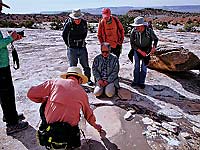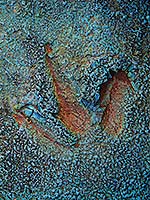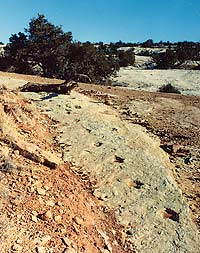Paleo HAPPENINGS January 2020 |
||
| Dinosaur Tracking Around Moab by Martin Lockley & Doug Tree of Moab Giants |
||
More good news: Moab has become a globally important destination for paleontologists looking for both fossils footprints, called trace fossils, and skeletal remains, or bones, known as body fossils. While paleontologists from the Utah Geological Survey, University of Colorado and other institutions describe new dinosaur finds for the scientific record, it is often local residents who make important discoveries. For example , Lin Ottinger, owner of the Moab Rock shop, discovered Utahraptor one of the Moab area’s globally-famous dinosaurs. The late Fran Barnes discovered dozens of dinosaur tracksites around Moab and wrote two short books on the subject. The Mill Canyon Dinosaur Tracksite, now a spectacular and easily-accessible destination, was also found by a local resident. So, if you want to go dinosaur tracking here are some engaging, participatory  suggestions. First link up with the Moab chapter of the Utah Friends Paleontology utahpaleo.org, and their network of Utah and Colorado paleontologists. At least three geologists, including both authors of this article, work regularly out of Moab Giants and go tracking with local residents and other professional paleontologists. We represent the informal Dinosaur Trackers Research Group that has found and described dozens of sites in the area, over 30+ years, including most of the five sites that the BLM and Forest Service have developed as interpretative sites, with available $3 guide. suggestions. First link up with the Moab chapter of the Utah Friends Paleontology utahpaleo.org, and their network of Utah and Colorado paleontologists. At least three geologists, including both authors of this article, work regularly out of Moab Giants and go tracking with local residents and other professional paleontologists. We represent the informal Dinosaur Trackers Research Group that has found and described dozens of sites in the area, over 30+ years, including most of the five sites that the BLM and Forest Service have developed as interpretative sites, with available $3 guide.  This is the first of a series of short Moab Happenings articles in which we discuss the joys and educational value of Dinosaur Tracking. Unlike bones dinosaur tracks represent living animals and their behavior: walking, running, alone or in groups, sometimes turning or limping or even squatting down. Also, while a dinosaur can leave only one skeleton, it can leave thousands of tracks, so they are relatively common. In the Moab area there are tracksites which range in age from the Late Triassic through the Jurassic to the Cretaceous (from about 200 to 70 million years old). These have yielded not only dinosaur tracks but also those of pterosaurs, lizards and mammal ancestors. In forthcoming articles we will share pictures and details of some of the more interesting sites scientists, local residents and land managers protect our prehistoric heritage resources and promote the fascinating stories they tell. This is the first of a series of short Moab Happenings articles in which we discuss the joys and educational value of Dinosaur Tracking. Unlike bones dinosaur tracks represent living animals and their behavior: walking, running, alone or in groups, sometimes turning or limping or even squatting down. Also, while a dinosaur can leave only one skeleton, it can leave thousands of tracks, so they are relatively common. In the Moab area there are tracksites which range in age from the Late Triassic through the Jurassic to the Cretaceous (from about 200 to 70 million years old). These have yielded not only dinosaur tracks but also those of pterosaurs, lizards and mammal ancestors. In forthcoming articles we will share pictures and details of some of the more interesting sites scientists, local residents and land managers protect our prehistoric heritage resources and promote the fascinating stories they tell.
|
||
